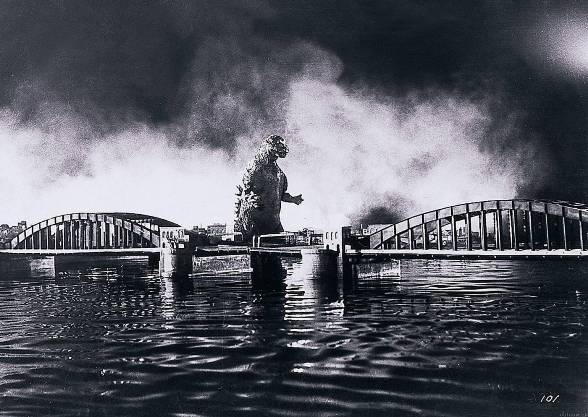
Godzilla (1954) / Sci Fi-Horror
aka Gojira
aka Godzilla, King of the MonstersMPAA Rated: Not rated, but probably PG-13 for violence and scenes of destruction
Running Time: 96 min.Cast: Takashi Shimura, Momoko Kochi, Akira Takarada, Akihiko Hirata, Sachio Sakai, Fuyuki Murakami, Ren Yamamoto
Director: Ishiro Honda
Screenplay: Ishiro Honda
Review published May 10, 2014
 Released
as Gojira in 1954, there
would be two versions of Godzilla - one
the original Japanese-only release and the other an English-dubbed
release (often titled Godzilla King Of the Monsters) that inserts 'flashback' scenes of actor Raymond Burr,
portraying American reporter Steve Martin, for the US-distributed
release in 1956, and tones down some of the potent allusions regarding
the US use of nuclear weapons on Japanese cities. Either one is
generally fine
for escapist viewing, as they are, more or less, the same basic plot at its
core, even if they seem very different in tone and characterizations.
However, true fans would scoff at anyone preferring the chopped-up
American version over the original Japanese, so I suppose from a true
Godzilla fan standpoint, it's best to introduce yourself with the original
uncut version before seeing the re-edited Hollywood feature.
Released
as Gojira in 1954, there
would be two versions of Godzilla - one
the original Japanese-only release and the other an English-dubbed
release (often titled Godzilla King Of the Monsters) that inserts 'flashback' scenes of actor Raymond Burr,
portraying American reporter Steve Martin, for the US-distributed
release in 1956, and tones down some of the potent allusions regarding
the US use of nuclear weapons on Japanese cities. Either one is
generally fine
for escapist viewing, as they are, more or less, the same basic plot at its
core, even if they seem very different in tone and characterizations.
However, true fans would scoff at anyone preferring the chopped-up
American version over the original Japanese, so I suppose from a true
Godzilla fan standpoint, it's best to introduce yourself with the original
uncut version before seeing the re-edited Hollywood feature.